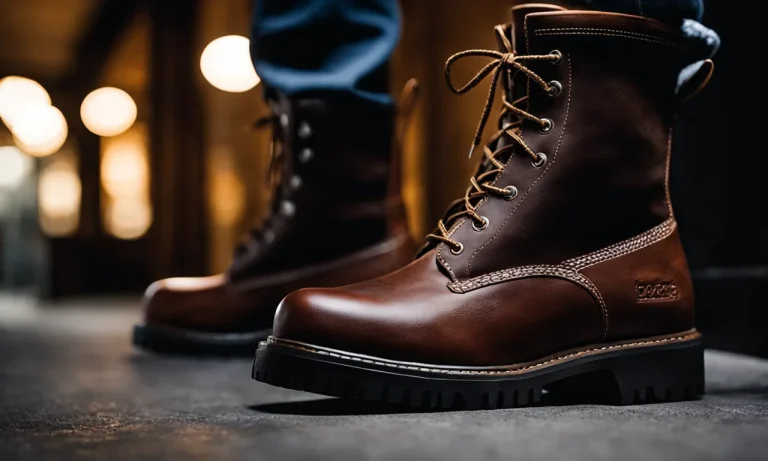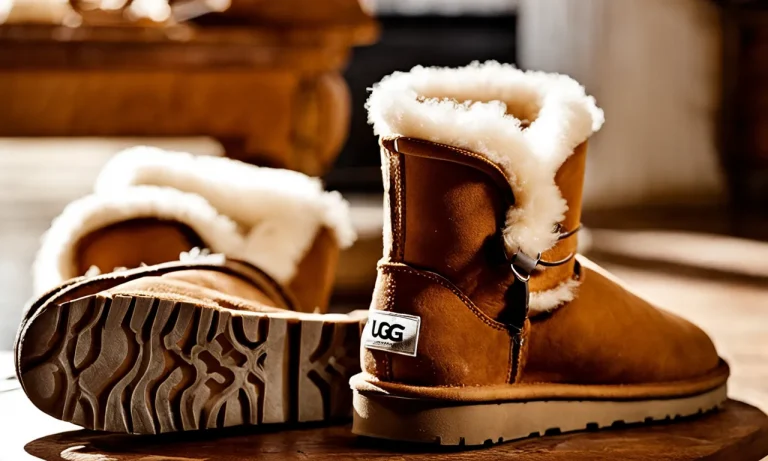If you’ve ever had the tongue of your shoe slide to the side while walking or running, you know how annoying it can be. A crooked shoe tongue can cause discomfort and ruin the look of an otherwise stylish shoe. Luckily, there are some simple tricks you can use to keep the tongue in its proper place.
If you’re short on time, here’s a quick answer to your question: Use shoelaces, tongue pads, or tape to help secure the tongue and prevent it from sliding around. Properly lacing your shoes and tying them snugly can also help hold the tongue in position.
In this comprehensive guide, we’ll go over several effective methods for keeping your shoe tongues from sliding around so you can walk comfortably and confidently.
Properly Lace and Tie Your Shoes
One of the key factors in keeping the tongue of your shoe in place is to lace and tie your shoes properly. Here are some important tips to consider:
Start with the bottom eyelets
When lacing your shoes, it is essential to start with the bottom eyelets. This ensures that the tension is evenly distributed throughout the lacing process. By starting at the bottom, you can create a secure foundation for the rest of the lacing.
Apply even tension when lacing
As you progress with lacing your shoes, make sure to apply even tension. This means pulling the laces snugly but not too tight. Applying uneven tension can cause the tongue to shift or slide out of place. Take your time and adjust the tension as needed to keep the tongue in its proper position.
Use a secure knot like a double knot
Once you have laced your shoes, it’s important to tie them securely to keep the tongue in place. One of the most reliable methods is using a double knot. This involves tying a regular knot and then looping the laces through again before tying another knot.
The double knot provides extra security and helps prevent the laces from coming undone throughout the day.
Remember, proper lacing and tying techniques are essential for keeping the tongue of your shoe in place. By starting at the bottom eyelets, applying even tension, and using a secure knot like a double knot, you can ensure that your shoes stay comfortable and secure throughout the day.
Use Shoelace Locks or Lace Locks
When it comes to keeping the tongue of your shoe in place, one effective solution is to use shoelace locks or lace locks. These small devices are designed to secure your shoelaces and prevent them from becoming loose or untied throughout the day.
By using shoelace locks, you can ensure that your shoes stay comfortable and secure on your feet, without the need for constant readjustment.
How shoelace locks work
Shoelace locks, also known as lace locks or lace toggles, are simple yet ingenious devices that can be easily attached to your shoelaces. They work by creating a firm grip on the laces, preventing them from slipping or loosening.
The locks are typically made of durable materials such as plastic or metal, ensuring that they can withstand the wear and tear of daily use. To use shoelace locks, simply thread your laces through the locks and tighten them as desired.
Once in place, the locks will keep your laces securely fastened, allowing you to go about your day without worrying about your shoelaces coming undone.
Types of lace locks
There are several different types of shoelace locks available on the market, each offering its unique features and benefits. One common type is the spring-loaded lock, which uses a small spring mechanism to hold the laces in place.
Another popular option is the slide-lock, which features a sliding mechanism that allows you to adjust the tightness of the laces easily. Additionally, some lace locks come in the form of decorative charms or accessories, adding a touch of style to your shoes while keeping the tongue in place.
Regardless of the type you choose, lace locks are a practical and convenient solution for keeping your shoelaces secure.
Where to position the locks
When using shoelace locks, it’s important to position them correctly for maximum effectiveness. The ideal placement for the locks is near the top of the shoe, where the laces begin to cross over each other.
This position allows the locks to secure the initial part of the laces, preventing them from slipping down and causing the tongue to become misaligned. Placing the locks too low on the laces may not provide sufficient support to keep the tongue in place, while positioning them too high may interfere with the overall fit of the shoe.
Experiment with different placements to find the position that works best for you.
Try Tongue or Lace Pads
If you’ve ever experienced the annoyance of a shoe tongue that slips and slides out of place, you know how frustrating it can be. Fortunately, there are solutions available to keep your tongue in place and ensure a comfortable fit. One popular option is to use tongue or lace pads.
Leather, Gel, or Foam Pads
Tongue pads come in various materials, including leather, gel, or foam. These pads are designed to provide a cushioning barrier between your foot and the tongue of the shoe, preventing it from moving around. Leather pads are often preferred for their durability and breathability.
Gel pads offer excellent shock absorption and can mold to the shape of your foot for a customized fit. Foam pads are lightweight and provide a soft cushioning effect.
Advantages of Tongue Pads
Tongue pads have several advantages that make them a popular choice among shoe enthusiasts. Firstly, they help to alleviate discomfort and pressure points caused by a slipping tongue. By keeping the tongue in place, they ensure a more secure and snug fit, preventing the foot from sliding forward within the shoe.
Additionally, tongue pads can improve the overall fit of the shoe, especially if you have narrow or wide feet. They can also extend the life of your shoes by reducing friction and wear on the tongue.
Placement Tips
Proper placement of tongue pads is crucial to ensure their effectiveness. Here are some tips to help you place them correctly:
- Position: Place the pad on the underside of the tongue, near the top, where it makes contact with your foot.
- Centered: Ensure the pad is centered and aligned with the shoe’s lacing system.
- Securely Attached: Use the adhesive backing provided with the pad to securely attach it to the tongue.
- Test and Adjust: Put on your shoes and walk around to test the placement of the pad. If necessary, make adjustments to achieve the desired comfort and fit.
Remember, tongue pads are not a one-size-fits-all solution. Experiment with different types of pads and placements to find what works best for you. If you’re unsure about the right type of pad to use or how to properly place it, consult with a shoe professional or visit reputable shoe websites for more guidance.
Use Tape or Double-Sided Fabric Tape
One effective way to keep the tongue of your shoe in place is by using tape or double-sided fabric tape. This simple yet practical solution can help prevent the tongue from slipping or moving around while you walk or engage in physical activities.
How taping the tongue works
Taping the tongue of your shoe involves applying tape or double-sided fabric tape to the underside of the tongue and attaching it to the inner lining of the shoe. This creates a secure bond that keeps the tongue in place, preventing it from sliding sideways or bunching up.
By keeping the tongue securely in position, you can maintain optimal comfort and stability while wearing your shoes. This is especially useful for activities that require a lot of movement, such as running, hiking, or playing sports.
Types of tape to use
When it comes to choosing the right tape for keeping the tongue of your shoe in place, there are a few options to consider:
- Duct tape: Duct tape is a strong and durable option that provides a secure hold. However, it may leave residue on the shoe if removed.
- Double-sided fabric tape: Double-sided fabric tape is specifically designed for fabric materials, making it a great choice for keeping the tongue of your shoe in place without damaging the shoe or leaving residue.
- Sports tape: Sports tape is another option that provides good grip and support for the tongue of your shoe. It is commonly used by athletes to secure various body parts during physical activities.
Ultimately, the type of tape you choose will depend on personal preference and the specific needs of your shoes.
Taping techniques
Here are a few taping techniques to consider when using tape or double-sided fabric tape to keep the tongue of your shoe in place:
- Full-width taping: This technique involves applying tape or double-sided fabric tape across the entire width of the tongue, ensuring maximum coverage and stability.
- Partial taping: If you prefer a less noticeable solution, you can apply tape or double-sided fabric tape to only the sides or edges of the tongue, allowing for some flexibility while still keeping it in place.
- Crisscross taping: For added security, you can crisscross the tape or double-sided fabric tape across the tongue, creating a stronger bond and preventing any possibility of movement.
Experiment with different taping techniques to find the one that works best for you and provides the desired level of comfort and stability.
Remember, keeping the tongue of your shoe in place is essential for a comfortable and enjoyable experience. By using tape or double-sided fabric tape, you can ensure that your shoes fit properly and stay in position, allowing you to focus on whatever activity you’re engaged in without any distractions.
Consider Other Specialty Products
When it comes to keeping the tongue of your shoe in place, there are a few specialty products that can help. These products are designed specifically to address the common issue of tongue slippage, providing a solution that is both effective and convenient.
Tongue holders
Tongue holders are small accessories that attach to the sides of your shoe’s tongue, ensuring it stays in place throughout the day. These holders are typically made from durable materials such as plastic or metal, and they come in various designs to suit different shoe styles.
Simply attach them to the sides of the tongue and adjust as needed for a secure fit. Tongue holders are a great option for those who prefer a simple and discreet solution to keep their shoe tongues from sliding around.
Elastic bands
Another option to consider is using elastic bands to keep your shoe tongue in place. These bands are specifically designed to wrap around the top part of your shoe, securing the tongue in position. They are typically made from stretchy materials that allow for flexibility and comfort.
Elastic bands are a practical choice for individuals who prefer a customizable solution, as they can be adjusted to fit different shoe sizes and tongue thicknesses. Plus, they are easily removable and reusable, making them a convenient option for everyday use.
Aftermarket tongue replacements
If you find that your shoe’s tongue is constantly slipping and none of the above options seem to work, you might want to consider aftermarket tongue replacements. These replacements are designed to replace the original tongue of your shoe with a more secure and stable alternative.
They are often made from high-quality materials that provide better grip and prevent slippage. Additionally, aftermarket tongue replacements come in various styles and colors, allowing you to customize the look of your shoes while also addressing the tongue slippage issue.
Be sure to check out reputable shoe accessory retailers or websites for a wide range of options.
Remember, everyone’s feet are different, and what works for one person may not work for another. It may take some trial and error to find the solution that works best for you. Don’t be discouraged if the first option you try doesn’t provide the desired results.
Keep exploring different products until you find the one that keeps your shoe tongue in place comfortably and securely.
Conclusion
A constantly sliding shoe tongue can quickly go from annoying to unbearable. Fortunately, with the right techniques and products, you can keep your shoe tongues locked in place for good. Test out different lacing methods, use specialty locks and pads, or get creative with tape.
With some trial and error, you’ll find the ideal setup for your footwear. No more distractions on your walks, runs, and workouts – just comfortable shoes with tongues that stay put right where they belong.






